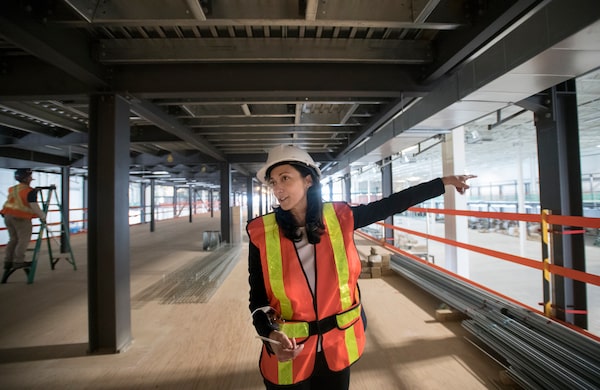
Sarah Joyce, senior vice-president of e-commerce for Sobeys, is photographed in the Vaughan, Ont., area where Sobeys is also building a fulfilment centre.Fred Lum/The Globe and Mail
Sobeys Inc. is raising the stakes in the online food wars as it rushes to catch up with rivals.
The country’s second largest grocer is more than doubling its bet on e-commerce technology – to $190-million – with plans to build a robotic warehouse in Montreal in addition to the one under construction in Vaughan, Ont., north of Toronto, for home-delivered goods.
The massive Vaughan warehouse, the size of 15 hockey rinks, is on track to open in the spring of 2020 and will cost $95-million, $25-million more than its original 2018 estimate, said Sarah Joyce, senior vice-president of e-commerce at Sobeys, which is owned by parent company Empire Co. Ltd. The steeper figure is mainly because of higher-than-expected prices for steel and other construction material and added design elements, she said.
Sobeys will team up with Crombie Real Estate Investment Trust, which is partly owned by Empire, to build from scratch the Montreal warehouse, with Crombie picking up most of the $95-million tab for that one, said Ms. Joyce, clad in a hard hat, construction boots and safety vest as she toured the half-finished Vaughan site. Sobeys is calling its online delivery service “Voilà by Sobeys” (“Voilà par IGA” in Quebec).
Empire, of Stellarton, N.S., is moving into risky territory with its heavy investment in high-tech warehouses, in partnership with automated online grocer Ocado Group PLC of Britain, without having tested the waters with its first distribution centre in Vaughan. But it’s wagering the initiatives will help it win the race among grocers to deliver cybershopping to customers in a segment that today represents only about 1 per cent of the estimated $120-billion Canadian grocery market – but is growing quickly.
“No one is standing still,” Ms. Joyce said as a robot that looks like a dishwasher on eight wheels is rolled toward her. “We’ve got a hot hand. We’ve got the exclusive [in Canada] for the best technology in the world. Why wouldn’t we use that?”
Online grocery shopping is developing more slowly than other e-commerce because of the complicated logistics involved in picking, packing and delivering the goods, which can add to retailers’ costs. They have to keep food fresh while often handling many low-cost items, some of them bulky, and then getting the merchandise to different people’s homes.
Canadian food makers warn of job losses, plant shutdowns amid rising costs, trade uncertainty
Sobeys opens first FreshCo in Western Canada in push to grow discount business
Sobeys to delay changes to supplier payment terms by two months
As a result, grocers such as Loblaw Cos. Ltd., the country’s largest in the sector, have focused on a click-and-collect model in which customers purchase online and pick up their orders at stores or other designated locations. With 700 pick-up sites now, Loblaw is using new technology to ensure customers get in and out of its parking lots in less than five minutes to pick up their orders, Sarah Davis, president of Loblaw, told analysts last week.
The grocer is testing allowing customers to add to their orders up to an hour before pickup, she said. “Customers are telling us that they want faster turnaround on their orders,” she said.
Loblaw also provides online home deliveries for extra charges in partnership with U.S. delivery startup Instacart, which Walmart Canada also uses along with e-commerce pickups at 140 of its stores or PenguinPickUp locations.
Even so, consumers prefer home delivery to grocery pickups for their online shopping, according to market researcher Nielsen.
As well, a growing number of consumers is shopping for groceries online rather than in bricks-and-mortar stores: E-commerce shopping trips rose 11 per cent to 31.4 million in 2018 from the previous year but were flat at 2.2 billion in physical stores, Nielsen found.
Ms. Joyce said Sobeys is determined to benefit from the trend toward online grocery shopping. The retailer’s research has shown that it will rise from 1 per cent of the total grocery market to 2.5 per cent in three years and 5 per cent by 2025. In Britain, where Ocado dominates, grocery cybershopping makes up 8 per cent of the market and, in the United States, 4 per cent, and Canada will eventually catch up to those levels, she said.
Sobeys already offers e-commerce at its Quebec franchised IGA supermarkets and its B.C. Thrifty Foods stores.
They enjoy double-digit sales growth, year-over-year, with spikes of as much as 50 per cent, spokeswoman Jacquelin Weatherbee said. At IGA.net, 90 per cent of customers prefer home delivery to click-and-collect, she said.
Still, Ocado-driven robotic systems will significantly boost efficiencies and lower costs, Ms. Joyce said. It will allow Sobeys to charge the same prices for online goods that it does in its stores along with a “competitive” delivery fee, she said.
The Montreal warehouse, which is to be completed in 2021, will serve that city and as far away as Ottawa and Quebec City. At 285,000 square feet, it will be 7.5 per cent larger than the one in Vaughan, she said. Sobeys plans to have four robotic distribution centres in all eventually.